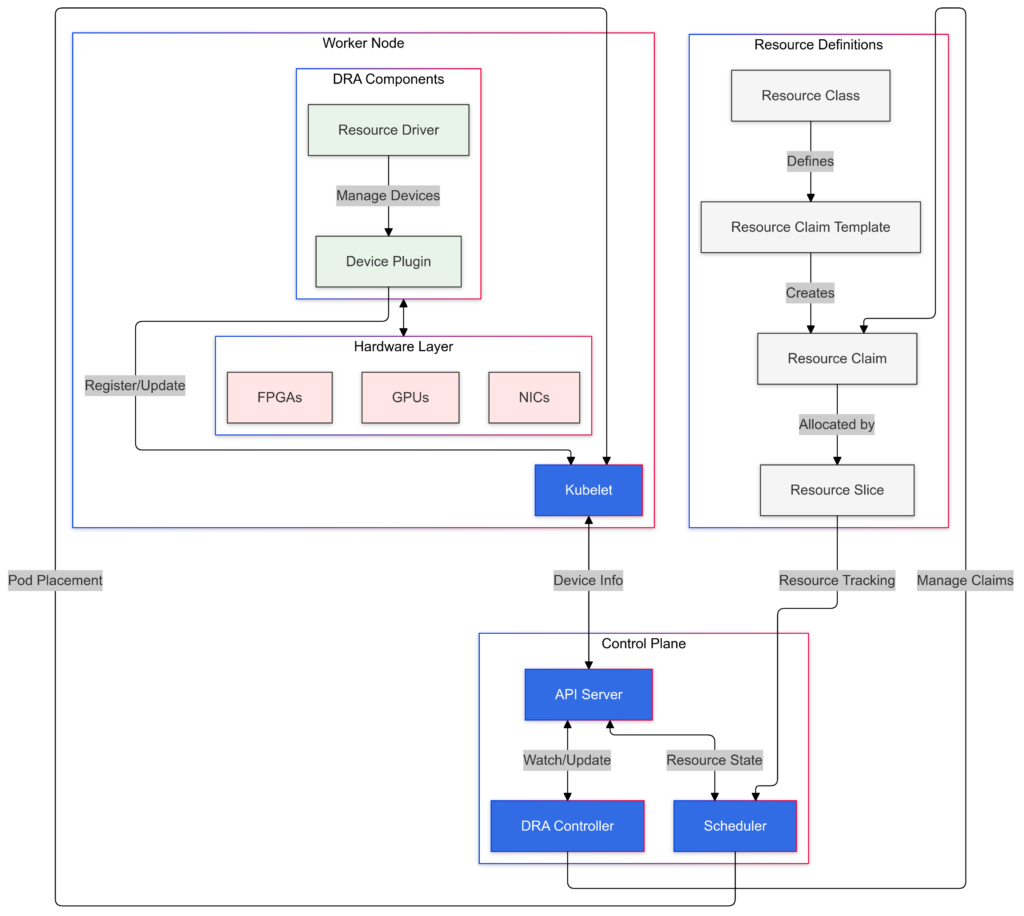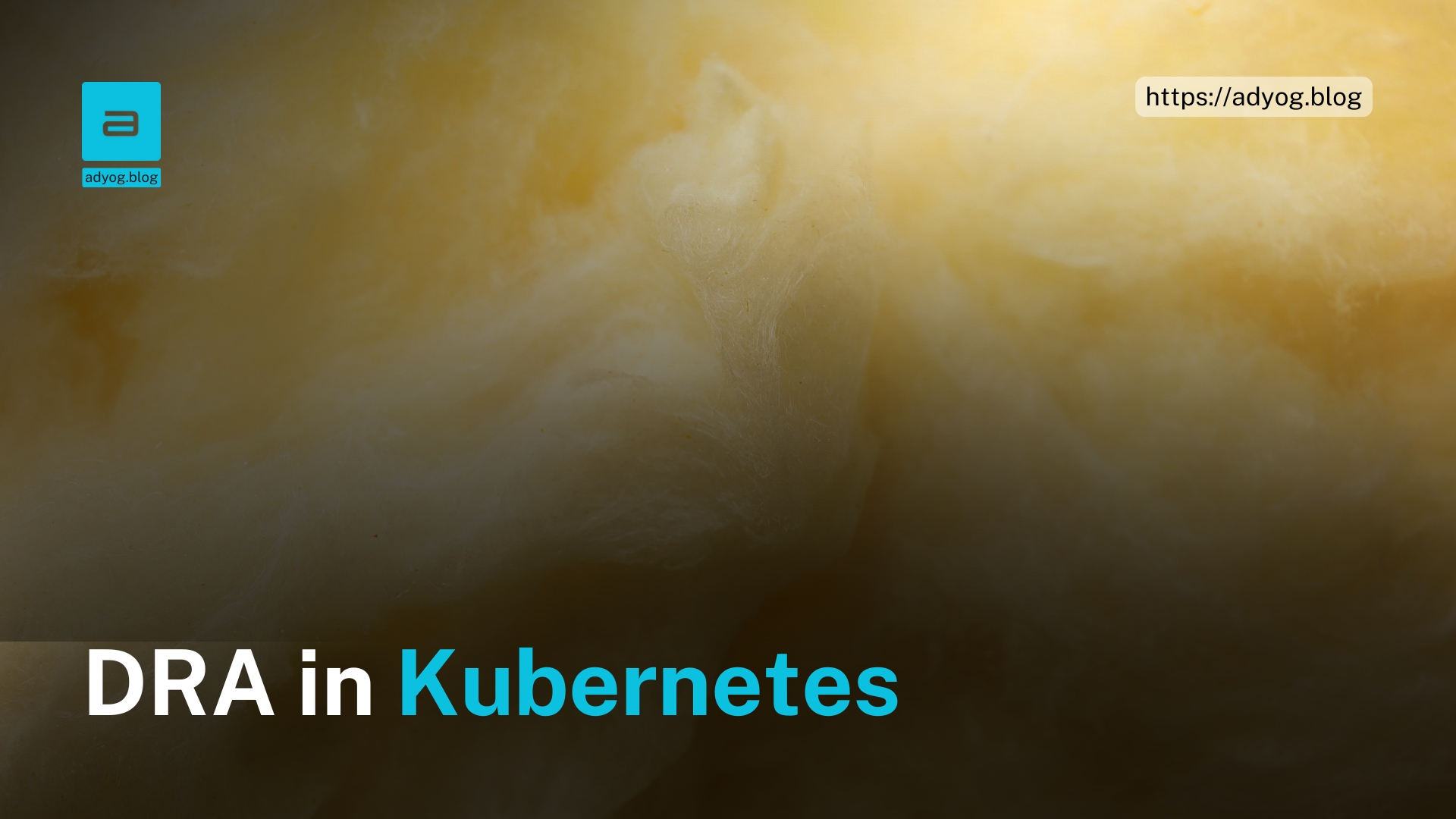Dynamic Resource Allocation (DRA) in Kubernetes represents a groundbreaking evolution in how hardware resources like GPUs, FPGAs, and NICs are allocated and managed for workloads. Unlike traditional device management, which offers static and coarse-grained resource handling, DRA introduces dynamic, fine-grained, and flexible allocation capabilities. This innovation is pivotal for AI/ML, HPC, and other complex workflows, making Kubernetes a more powerful platform for hardware-intensive applications.
In this article, we’ll explore:
- The foundational components of DRA.
- How it integrates with Kubernetes.
- Real-world use cases and troubleshooting strategies.
- Insights into its future potential.
1. Understanding Dynamic Resource Allocation
1.1 What is DRA?
Dynamic Resource Allocation is a Kubernetes framework that provides:
- Granular hardware control: Enables workloads to access specialized hardware based on specific requirements.
- Flexibility: Allows dynamic allocation and configuration of resources to maximize utilization.
- Extensibility: Supports various hardware types with customizable device drivers.
1.2 Why is DRA Necessary?
Traditional Kubernetes resource allocation falls short for AI and HPC workloads:
- Specialized hardware is scarce and expensive.
- AI workloads often require co-location of hardware components for optimal performance.
- Static allocation mechanisms lack the flexibility needed for dynamic workloads.
2. DRA Architecture: A Deep Dive
Dynamic Resource Allocation introduces several key components that work seamlessly within Kubernetes’ existing architecture.
2.1 DRA Architecture and Component Interactions
The architecture integrates DRA into the Kubernetes cluster through interactions between the control plane, worker nodes, and hardware layers.
Detailed DRA Architecture

2.2 Core Components of DRA
| Component | Role |
|---|---|
| Device Plugin | Publishes detailed hardware attributes to the API Server. |
| Resource Class | Defines reusable hardware specifications. |
| Resource Claim Template | Enables users to create dynamic resource claims. |
| Resource Claim | Requests specific hardware resources. |
| Resource Slice | Tracks and allocates hardware resources dynamically. |
| DRA Controller | Manages resource claims and device interactions. |
3. Implementing DRA in Kubernetes
3.1 Setting Up Device Plugins
Device plugins enable hardware-specific integrations. For example, setting up NVIDIA GPUs:
YAML Example: Device Plugin DaemonSet
apiVersion: apps/v1
kind: DaemonSet
metadata:
name: nvidia-device-plugin
namespace: kube-system
spec:
template:
spec:
containers:
- name: nvidia-device-plugin
image: "nvidia/k8s-device-plugin:1.0"
resources:
limits:
nvidia.com/gpu: 13.2 Configuring Resource Classes
Administrators can define reusable configurations for specific hardware.
YAML Example: Resource Class
apiVersion: resource.k8s.io/v1alpha1
kind: ResourceClass
metadata:
name: high-performance-gpu
parameters:
vendor: "nvidia"
memory: "16Gi"
type: "A100"3.3 Creating Resource Claims
Users request resources dynamically using claims.
YAML Example: Advanced Resource Claim
apiVersion: resource.k8s.io/v1alpha1
kind: ResourceClaim
metadata:
name: ai-training-claim
spec:
resourceClassName: high-performance-gpu
parameters:
memory: "32Gi"
type: "A100"4. Real-World Applications of DRA
4.1 AI Workloads
DRA optimizes AI training by co-locating GPUs and NICs on the same PCI bus, delivering up to 10x IO performance improvements.
4.2 High-Performance Computing (HPC)
HPC workloads leverage DRA for NUMA-aware CPU and memory allocations.
5. Troubleshooting and Best Practices
5.1 Common Challenges
| Challenge | Solution |
|---|---|
| Scheduling Conflicts | Ensure device plugins match hardware configurations. |
| Performance Bottlenecks | Use monitoring tools to validate hardware topology. |
5.2 Security and Observability
- RBAC Enforcement: Restrict unauthorized access to device plugins.
- Monitoring: Use tools like Prometheus and Grafana for real-time insights.
6. The Future of DRA in Kubernetes
Looking ahead, DRA will:
- Expand support for emerging accelerators.
- Introduce enhanced abstractions for simplified configurations.
- Address scalability challenges for large-scale deployments.
Conclusion
Dynamic Resource Allocation is revolutionizing Kubernetes’ approach to hardware management, bridging the gap between traditional infrastructure and AI-driven workloads. By leveraging DRA, platform engineers and developers can unlock unparalleled flexibility and efficiency in resource orchestration.
Join the Kubernetes Working Group Device Management to shape the future of DRA. Meetings are held biweekly on Tuesdays at 8:30 AM PST. Explore Kubernetes DRA Documentation for more details.





Leave a Reply